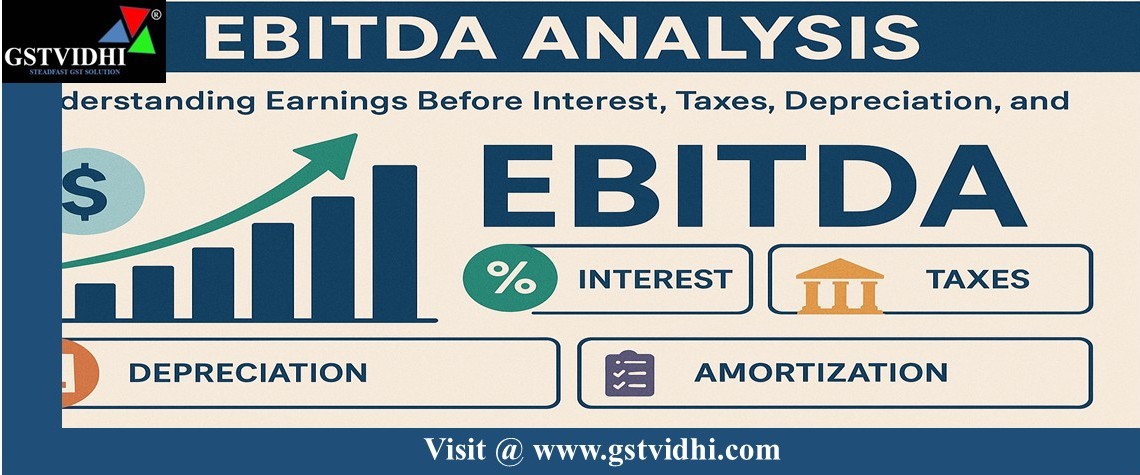
EBITDA Analysis: Understanding Earnings Before Interest, Taxes,
Depreciation, and Amortization
Introduction to
EBITDA
EBITDA stands for Earnings
Before Interest, Taxes, Depreciation, and Amortization. It is a widely-used
financial metric that gives insight into a company’s operational performance,
excluding the effects of financing decisions, tax environments, and non-cash
accounting entries.
EBITDA Formula:
EBITDA=Net Income + Interest
+ Taxes + Depreciation + Amortization
Alternatively, if you're
starting from operating income:
EBITDA=Operating Income (EBIT)+Depreciation
+ Amortization
Why Use EBITDA?
EBITDA helps investors,
analysts, and business owners:
- Understand core operating
profitability
- Exclude non-operating activities
(e.g., interest, taxes)
- Remove non-cash expenses
(e.g., depreciation and amortization)
- Compare companies within the same
industry more accurately
Example: Basic EBITDA
Calculation
Let’s say Company A
reports the following figures:
- Net Income:
₹5 crore
- Interest Expense:
₹1 crore
- Taxes Paid:
₹2 crore
- Depreciation:
₹1.5 crore
- Amortization:
₹0.5 crore
EBITDA = 5 + 1 + 2 + 1.5
+ 0.5 = ₹10 crore
This ₹10 crore figure
represents the company’s earnings before accounting for its financing
structure, tax position, and capital investment decisions.
EBITDA in
Financial Analysis
EBITDA is particularly
useful when analysts want to:
- Focus on the core business
operations without being distracted by financing and accounting
structures.
- Evaluate companies with heavy
capital expenditures (such as telecom, infrastructure, or
manufacturing).
- Assess operational efficiency
across firms or sectors with different financing strategies or tax
treatments.
Example: Peer Comparison
|
Company
|
Net
Income
|
EBITDA
|
Revenue
|
EBITDA
Margin
|
|
A
|
₹5
Cr
|
₹10
Cr
|
₹100
Cr
|
10%
|
|
B
|
₹3
Cr
|
₹9
Cr
|
₹90
Cr
|
10%
|
|
C
|
₹2
Cr
|
₹8
Cr
|
₹110
Cr
|
7.27%
|
Here, even though net
incomes differ, EBITDA allows for a clearer comparison of operating
performance.
Limitations of
EBITDA
Despite its utility,
EBITDA has several limitations, especially when used in isolation:
1. Can Overstate
Financial Health
EBITDA can make unprofitable
firms appear attractive by excluding major expenses. For example, a company
with high debt might show strong EBITDA but is still unable to meet its debt
obligations.
2. Easy to Manipulate
It’s not a GAAP
(Generally Accepted Accounting Principle) measure, meaning companies can
calculate it differently. Fraudulent firms can inflate revenue and hide
real expenses to make EBITDA look better.
3. Ignores Working
Capital Needs
EBITDA doesn’t include changes
in working capital (e.g., inventory buildup or increased receivables),
which can seriously impact cash flow.
4. Not a Substitute for
Cash Flow
Cash flow is a better
measure of liquidity. EBITDA ignores:
- Capital expenditures
- Working capital changes
- Actual tax and interest payments
EBITDA vs.
Operating Cash Flow
|
Metric
|
Includes
Working Capital?
|
Includes
Interest & Tax?
|
Captures
Real Cash Movement?
|
|
EBITDA
|
No
|
No
|
No
|
|
Operating
Cash Flow
|
Yes
|
Yes
|
Yes
|
Example: EBITDA vs.
Operating Cash Flow
- EBITDA: ₹10 Cr
- Capital Expenditure: ₹6 Cr
- Change in Working Capital: -₹3 Cr
- Operating Cash Flow = ₹10 Cr - ₹6 Cr
- ₹3 Cr = ₹1 Cr
This shows that even with
a high EBITDA, the company is generating only ₹1 Cr of real cash,
raising questions about sustainability.
When and How to
Use EBITDA Effectively
Despite its flaws, EBITDA
can still be very useful:
1. Debt Service Coverage
EBITDA is used as a proxy
for operating cash flow when analyzing the company’s ability to pay debt.
EBITDA / Debt Payment =
Debt Coverage Ratio
If EBITDA is ₹20 Cr and
annual debt payments are ₹5 Cr, the debt coverage ratio is 4.0—indicating a
comfortable buffer.
2. Industrial Firms &
Capital-Heavy Businesses
In companies where depreciation
and amortization reflect long-term asset usage (like airlines,
manufacturing), EBITDA provides clarity into day-to-day profitability.
3. Comparative Valuation
Valuation multiples like EV/EBITDA
are commonly used to value firms within an industry:
EV/EBITDA=Enterprise Value
EBITDA
A lower ratio may
indicate an undervalued stock, but only when comparing similar firms.
EBITDA and
Dotcom Misuse
The misuse of EBITDA
gained attention during the 1990s dotcom boom. Startups with no
profits or even sales were valued based on EBITDA, giving investors a misleading
sense of profitability. Similar patterns emerged in telecoms and tech
companies where constant upgrades and capital expenditures were ignored
in EBITDA calculations.
Conclusion: Use With
Caution
EBITDA is a valuable
tool—but it’s not a comprehensive indicator of financial health. Use it:
- To assess operating efficiency
- For industry comparisons
- As a debt-servicing gauge
But don’t forget:
- It excludes vital factors like
working capital and capital expenditures
- It can be manipulated
- It should not replace
operating cash flow in thorough analysis
Disclaimer: All the Information is strictly for educational purposes and on the basis of our best understanding of laws & not binding on anyone.
Click here